web3 Finance
~Opportunities and Threats for Insurers Brought by DeFi
July 11, 2022
In April 2022, Digital Society Promotion Office of the Liberal Democratic Party in Japan released "Digital Nippon 2022," a set of concrete recommendations for “New Capitalism”. (*1)
In the recommendations, web3 is one of the growth drivers for realizing a "sustainable society where everyone can experience growth and happiness."
This Insight article focuses on the insurance function of DeFi as one of the use cases of web3, and examines opportunities and threats to insurance companies.
Note: This article is solely intended to provide insight on web3 and DeFi, and is not a recommendation for any investments. As web3-related issues change rapidly, conditions and trends may have changed since this writing.
1. web3 for the New Capitalism
The web is a standardized system for publishing and viewing documents on the Internet. With the emergence of blockchain technology, it developed into the concept of web3 in 2021. Before that, in Web 1.0, when the Internet was born in 1991, anyone could distribute information through homepages and e-mail magazines without relying on mass media such as TVs, radios, newspapers, and magazines. In Web 2.0, the Internet further developed in the 2000s, enabling interactive communication on platforms such as social networking services (SNS) and blogs, enriching people's lives. As a result, such service platforms have become indispensable to people's lives.
The Internet was initially created to democratize information for people to access quickly. However, it is dominated by a few giants, and personal data is collected and utilized in the way unintended by its owner. As a result, a few big Internet platformers, called BigTechs, monopolize wealth. (*2)
As a counterculture against the current state of the Internet, the concept of web3 has been arising since 2021, with the emergence of blockchain technology. In web3, we can manage data in a decentralized (not centralized) way and own digital content as NFT (Non-Fungible Token). NFT is unique, non-fungible data/token recorded on the blockchain. (*3) As a result, companies and investors focus on the realization of web3 where creators own digital contents. (Figure 1).
Figure 1: Evolution of the Internet concept
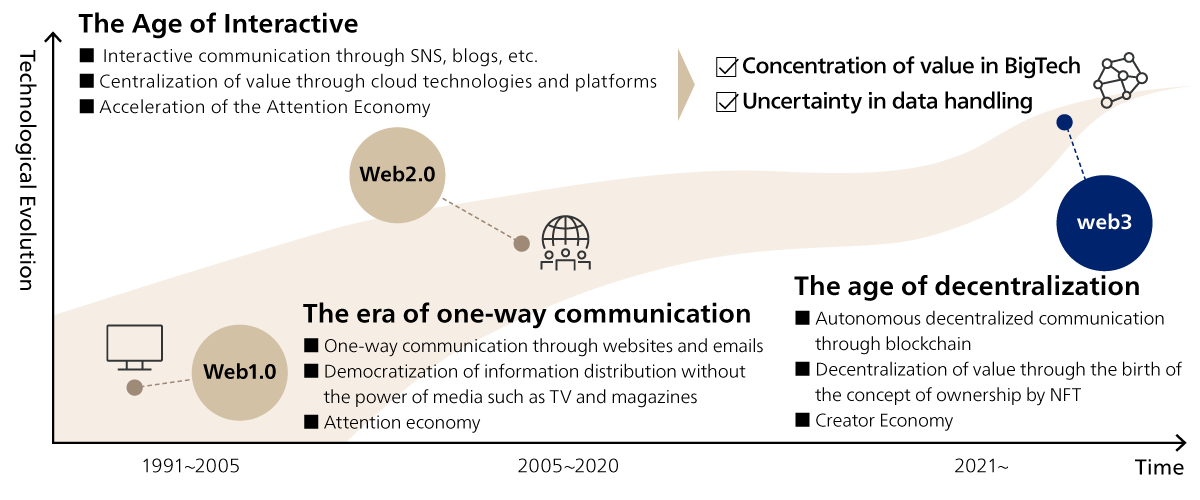
As web3 attracts excellent attention, its market proliferates, as seen in the figures (Figure 2). And it is comparable to the size of the Japanese economy (*4). For example, the market capitalization of the top 30 crypto assets which play the role of money and stocks in web3 was approximately 290 trillion yen in 2021, larger than the 250 trillion yen of the market capitalization of the top 30 Japanese stocks during the same period. In addition, the total trading value of the world's top 10 NFT exchanges is 2.7 trillion yen, larger than the 2.5 trillion yen in total traded in Japan's digital B2C market (digital content such as videos and manga/comics).
Figure 2: Market Size of web3
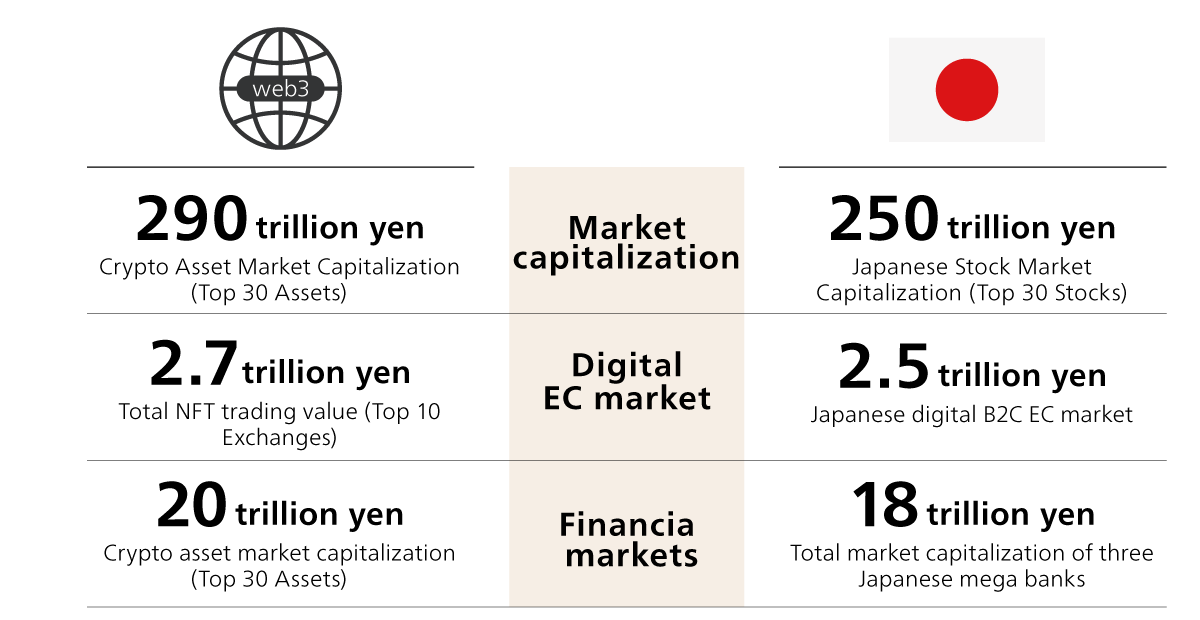
2. DeFi, supporting the financial side of web3
DeFi (Decentralized Finance), one of the leading use cases of web3, does not rely on centralized financial intermediaries such as exchanges or banks. Instead, DeFi uses smart contracts, which automatically execute contracts on the blockchain.
Conventional financial services are based on a mechanism of centralized finance. For example, banks borrow money from depositors with interest and extend loans to borrowers in the deposit and loan business. In the foreign exchange business, banks exchange one currency for another.
In DeFi, these financial transactions are conducted among the users on the blockchain. One example of DeFi is a cryptocurrency exchange carried out through DEX (Decentralized Exchange). In the case of an exchange between such major cryptocurrencies as Bitcoin (BTC) and Ethereum (ETH), a cryptocurrency holder pairs and deposits BTC and ETH to a liquidity pool (like “change machine”) at the DEX. Users who need ETH can gain ETH by giving BTC with fee to the “change machine”. The fee will be shared among those who deposit these cryptocurrencies.
Advantages of DeFi include 1) low operational costs and transaction fees due to the absence of a centralized intermediary, and 2) high transaction transparency since it operates based on smart contracts that anyone can refer. In fact, as of November 2021, approximately 20 trillion yen worth of crypto assets were deposited in the DEX, and it will be growing. (*5)
DeFi has not limited itself to providing financial functions in crypto assets. For example, it includes NFT-Fi, where interest is earned by depositing NFTs. It also includes GameFi (also known as “Play to Earn”), where revenue is earned from games created using blockchain technology. These DeFi financial applications are rapidly developing and becoming essential to the overall web3 ecosystem.
Figure 3: Main DeFi types
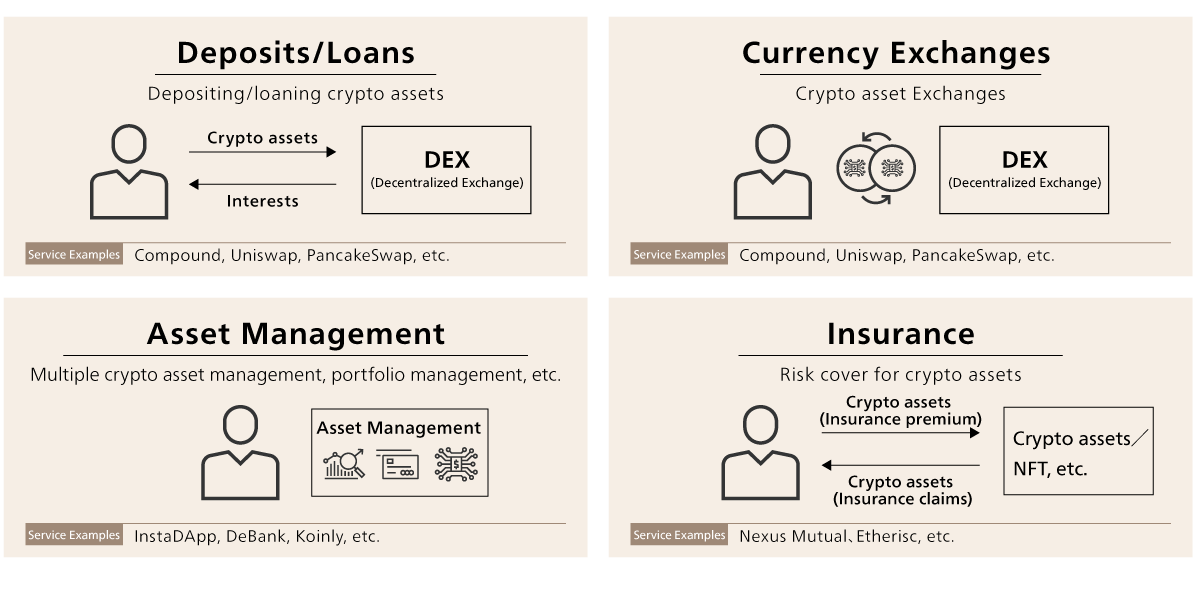
3. DeFi insurance, covering the increased risk to assets on DeFi
DeFi insurance is another DeFi example. At the time of this writing, its definition ranges from "insurance that covers risks to assets on DeFi" in a narrow sense to "insurance with smart contract-based processes and governance" in a broader sense. Despite these various definitions, we believe that DeFi insurance differs from traditional insurance in three ways.
The first is a narrow definition of DeFi insurance in covered risk. Conventionally, insurance covers the monetary loss risk to physical things such as people and property. Instead, DeFi insurance mainly covers risks to digital assets (e.g., crypto assets traded on DeFi).
The second is from the perspective of business operations. For example, conventional insurance is managed by a single organization, such as a stock company or mutual company. On the other hand, DeFi insurance is often managed by a decentralized organization called DAO (Decentralized Autonomous Organization), built on a blockchain with a common purpose.
Generally, a stock company is organized based on a pyramid structure, where the management team at the top of the organization make decisions, and employees at the bottom follow the decisions.
In contrast, a DAO builds smart contracts based on rules set at its establishment. DAO participants own "governance tokens" as participation rights to vote on DAO decisions and the vote becomes effective when approved by the number of voters defined in smart contract. For example, some DeFi insurances make claims payment decisions based on the votes with the governance tokens.
The third is from the viewpoint of the claim payment process. In conventional insurance policies, claim forms are sent to insurance companies along with various medical certificates, and payment is determined by an examiner using the insurance company's core system. This payment decision process is not accessible to the user. In contrast, in some cases in DeFi, the payment decision is automated by a program that can be referred to by anyone using smart contracts, making the process highly transparent.
Figure 4: Differences between DeFi Insurance and Conventional Insurance
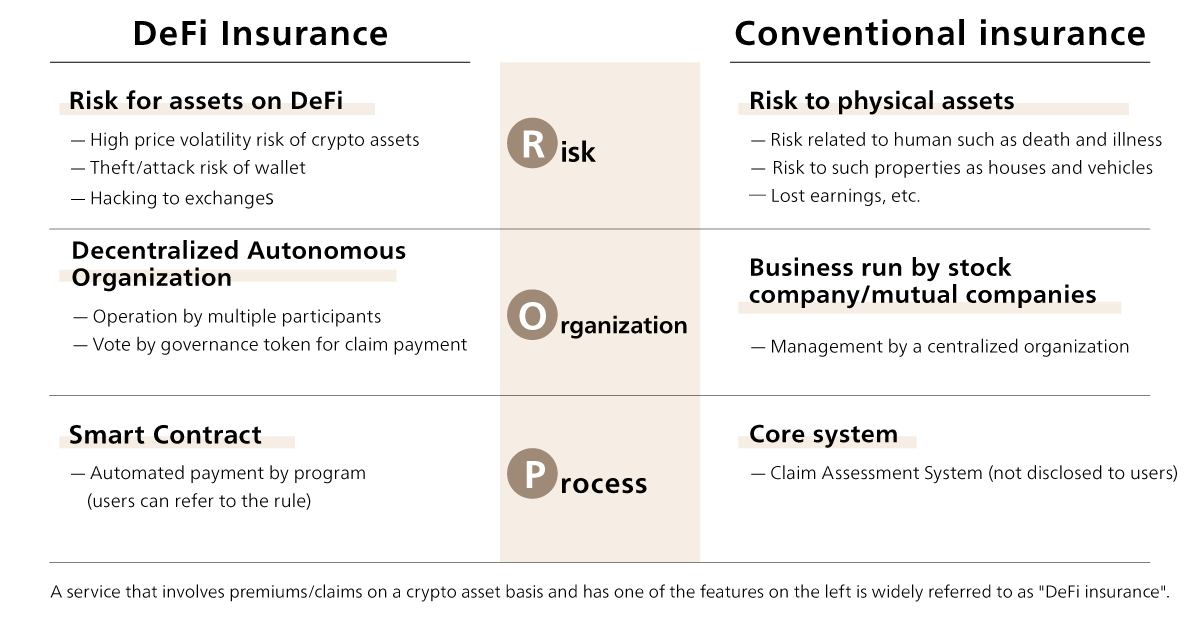
4. DeFi insurance is opportunity or threat to existing insurers?
DeFi insurance poses not only opportunities but also threats to existing insurance companies from the three perspectives of "market," "business model," and "service. A detailed discussion from these perspectives follows.
First, from a market perspective, as mentioned earlier, the web3 market has expanded to more than the size of a country's economy. This growing market represents a significant business opportunity for established insurance companies. On the other hand, emerging insurance players covering DeFi assets risk may enter the traditional insurance market, posing a threat to established insurers. In fact, in emerging markets, DAOs have been formed by companies, organizations, and tech companies, including insurance companies, to provide agricultural risk insurance. (*6)
Second, we discuss from a business model perspective. In the current insurance business, salaries of insurance company employees and agency commissions are generally comprised in the premiums paid by policyholders as operating expense. The policyholders pay these commissions as part of the compensation to insurance companies underwriting the risk.
DeFi insurance, on the other hand, has a cost advantage over existing insurance companies. DeFi insurance often automates the claims payment process through a program, smart contract. As a result, DeFi insurance may force established insurance companies to rethink their commission business model. On the other hand, insurers can unbundle their functions as they participate in the DAO economy for monetization opportunities with a new business model. Furthermore, they can gain greater transparency in decision-making processes and operation rules, which will help lead to greater customer trust.
Third, we discuss products and services. As DeFi insurance is based on blockchain and smart contracts, it can be purchased by anyone from anywhere, as long as they have Internet access. As some DeFi insurance products have emerged , borderless competition has begun. However, the fact that most of insurers haven't yet gotten involved in the DeFi insurance movement may disadvantage them.
In addition, insurers can improve operational efficiency by integrating blockchain technology into their business processes. Also, they can develop and launch new services based on ever-changing web3 concepts and trends. These are great opportunities for them (we will discuss this further in the next chapter).
Figure 5: Opportunities and Threats for Insurers
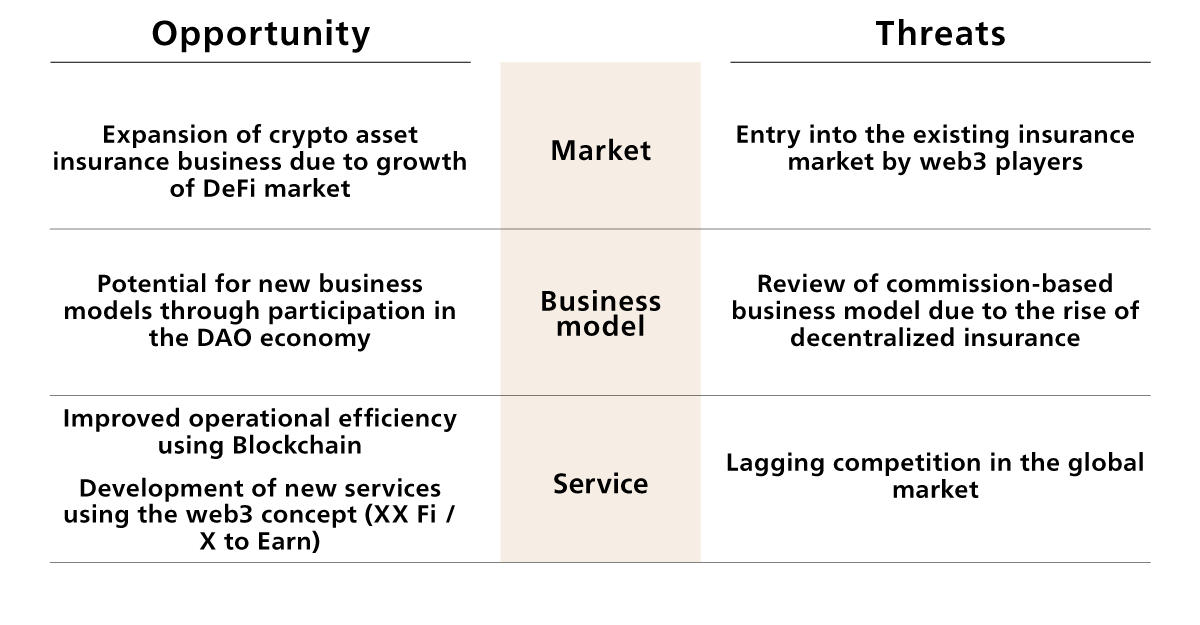
5. Actions for insurance companies
Attracting great public attention, web3 and DeFi present great opportunities and, at the same time, threats. Finally, we discuss what insurance companies should do to cope with web3 and DeFi movement.
Given the current state of various systems and laws, it is not easy for insurers to enter the "business to cover assets on DeFi." Therefore, we believe that insurance companies need to take the first step to "learn" about DeFi insurance from a medium-term perspective by researching advanced cases and protocols, as well as participating in DAOs.
In addition, we believe that from a short-term perspective, insurance companies can develop new services based on the web3 concept. For example, we refer to "STEPN (*7)" from the Move to Earn project, a GameFi, one of the web3 use cases, related to health and longevity risks.
STEPN is a blockchain game in which users can earn crypto assets by buying NFT sneakers, putting them on the app, and running or walking. Ten minutes of exercise daily can make the equivalent of several hundred yen in crypto assets. As a result, the game has changed behavior among home workers who rarely go out or users who had not been in the habit of exercising.
The incentives that cause these behavioral changes have two design aspects: economic value and social contribution value. The former is economic value design based on Tokenomics (token economy) (*8) with crypto assets. The latter is social value design by the game operator, which promises from the beginning of the service launch to allocate a portion of game revenues to purchase carbon credits for carbon neutrality. (*9)
Finally, by utilizing the web3 mechanism and technology, we can increase customer contacts, urge people to change their behavior in ways that could not be achieved with the traditional insurance, and develop services to solve social issues.
ABeam Consulting is working to create business for well-being and social good expected in web3 era by leveraging deep insights on insurance from strategy to operation, insights on emerging technologies and trends, and know-how and talents for new business development. Stay tuned for our coming web3 related publications. Feel free to contact us when you have interests in this Insight.
-
*1:https://jimin.jp-east-2.storage.api.nifcloud.com/pdf/news/policy/203427_1.pdf
*2:In 2020, the total market capitalization of the five GAFAM companies (Google, Apple, Facebook/Meta, Amazon, and Microsoft) exceeded that of the entire First Section of the Tokyo Stock Exchange
*3:For example, Instagram's Terms of Service stipulate that "We (omitted) do not claim ownership of any User Content. On the other hand, it states, "You grant us a (~omitted~) license to (~omitted~) host, use, distribute, modify, perform, and reproduce (~omitted~) your content. As the user uses the service, the user effectively provides Meta with the right to use the content. This point can also be seen in a16z’s report stating, “In 2021, primary sales of Ethereum-based NFTs (ERC-721 and ERC-1155), plus the royalties paid to creators from secondary sales on OpenSea, yielded a total of $3.9 billion. That’s quadruple the $1 billion (~omitted~) that Meta has earmarked for creators through 2022.”(https://a16zcrypto.com/state-of-crypto-report-a16z-2022/)
*4:Partially modified based on https://mirror.xyz/naritaiki.eth/hZdKC8xUcuhK7HqUeN0v9GVCa0CZ8A5ceOaBdmiPtYs
*5:On the other hand, DeFi's risks include human errors like mistakes during money transfer or loss of the wallet's "private key" (the loss is self-responsibility) and the high price volatility of the crypto asset itself.
*6:https://www.lemonade.com/blog/crypto-climate-coalition/
*8:A combination of the words "token" and "economy." There are token types issued in-game, incentive models, token distribution models, etc. STEPN urges users to use tokens to purchase items such as shoe repairs, level-ups, and gems. Therefore, tokens earned are not immediately redeemed for cash, leading to sustainable behavior change by urging users to spend tokens within the STEPN economic sphere.
*9:https://stepnofficial.medium.com/stepn-taking-bold-steps-toward-carbon-neutrality-766297728417



